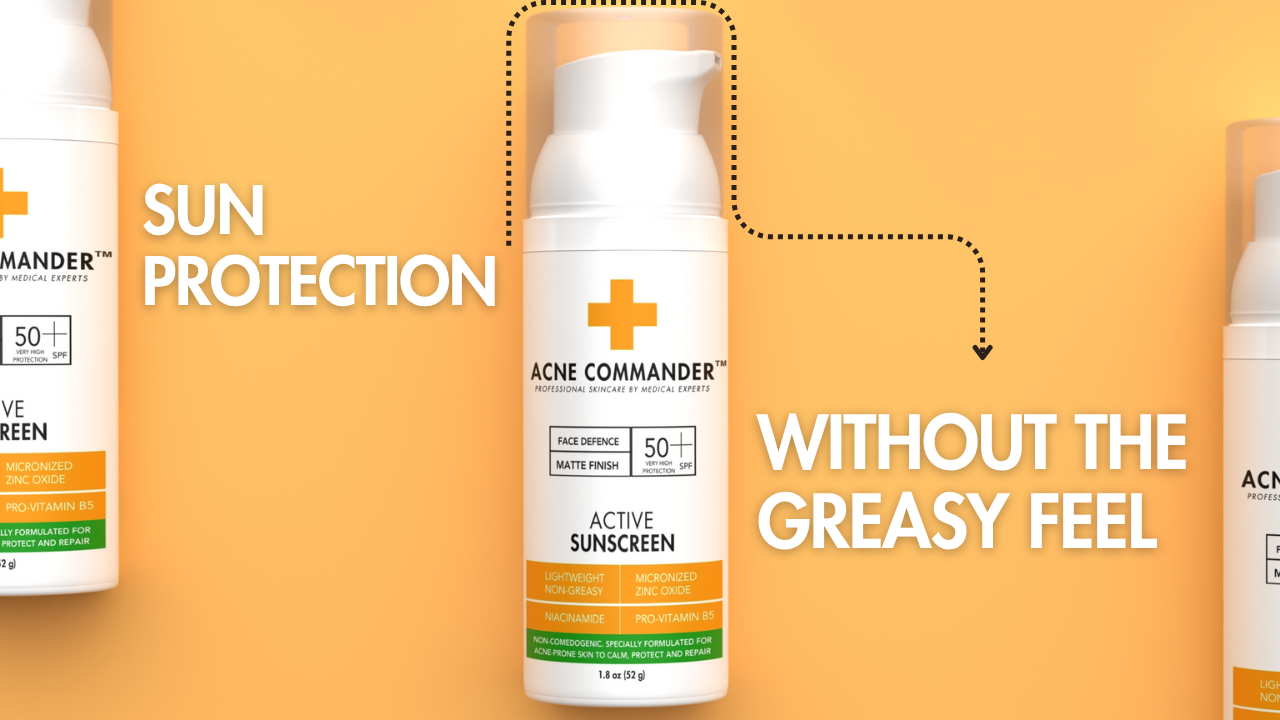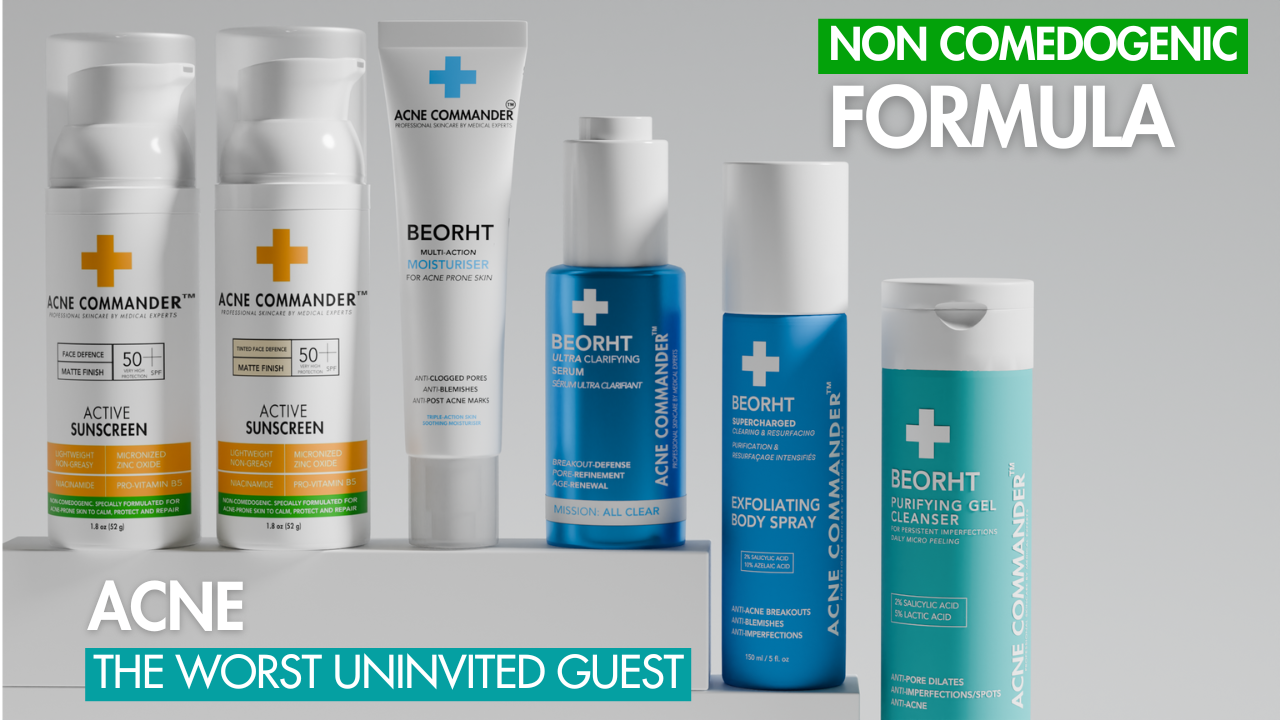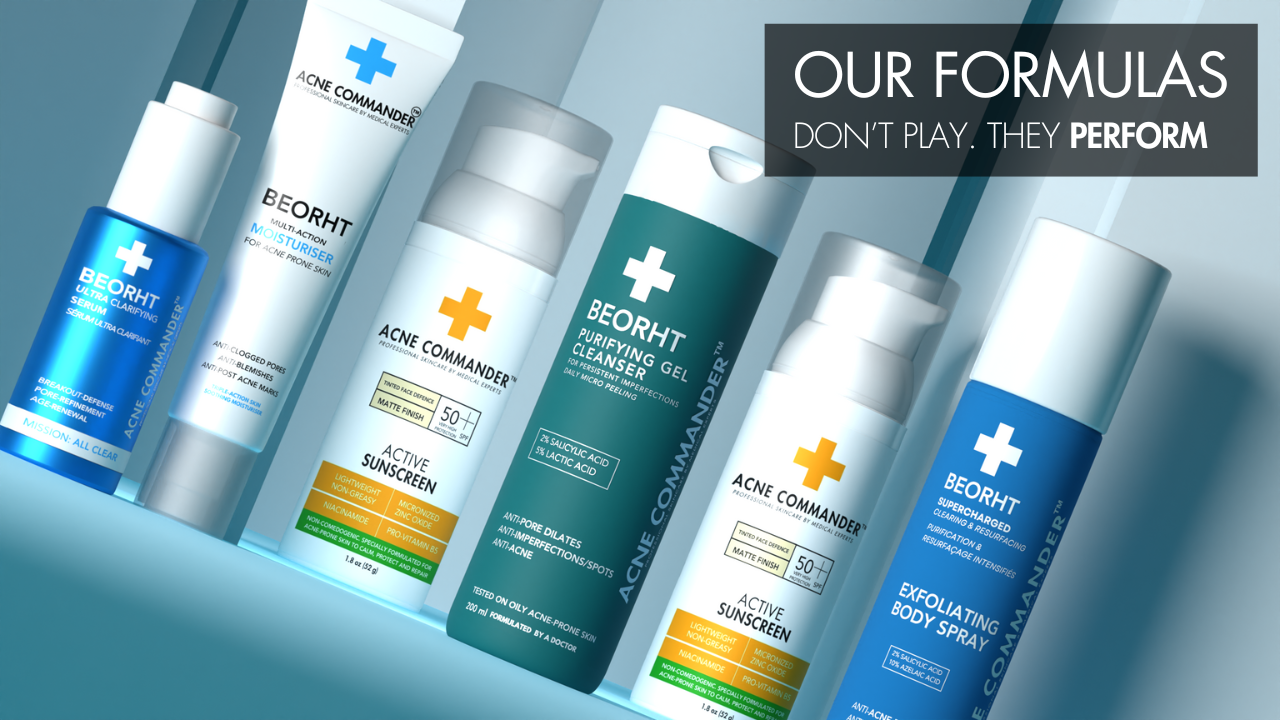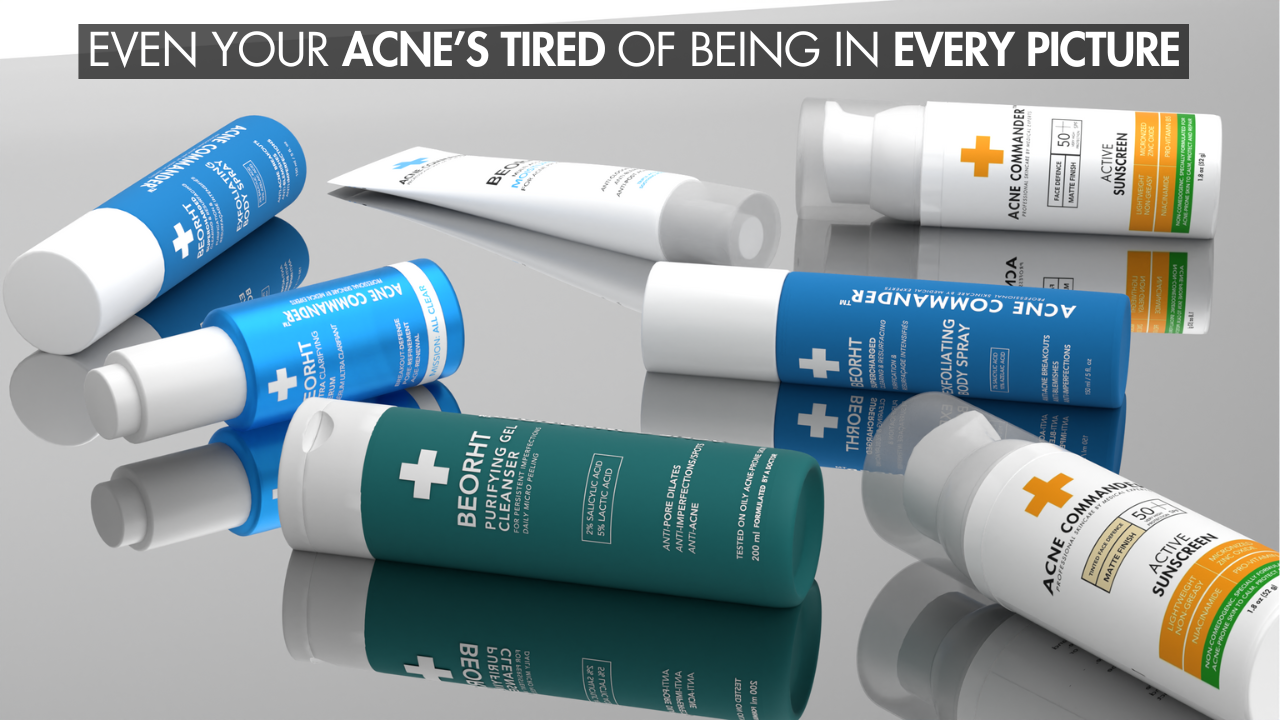Introduction
When it comes to treating acne, finding the right cleanser is a crucial step in your skincare routine. But while many people focus on active ingredients like Salicylic Acid or Benzoyl Peroxide, one often overlooked factor is the pH level of the cleanser. What is the ideal pH level for an acne cleanser, and why does it matter?
The pH level of a cleanser plays a vital role in how it interacts with your skin, particularly when it comes to acne. If the pH is too high or too low, it can disrupt your skin’s natural balance, leading to irritation, dryness, and even worsening acne. Understanding the ideal pH level for an acne cleanser can help you choose the right products and optimize your skincare routine.
In this article, we’ll explore the importance of pH in acne treatment, the ideal pH range for acne cleansers, and how to choose the best cleanser based on pH. We’ll also highlight Acne Commander’s Beorht Purifying Gel Cleanser, a pH-balanced cleanser that works well for acne-prone skin.
What Is pH and Why Does It Matter for Acne Treatment?
pH is a measure of how acidic or alkaline a substance is. It is measured on a scale from 0 to 14, with:
-
pH 0 to 6 being acidic
-
pH 7 being neutral
-
pH 8 to 14 being alkaline (basic)
Your skin’s natural pH is slightly acidic, usually around 4.5 to 5.5. This slightly acidic environment is essential for the skin's barrier function, which helps protect the skin from environmental damage, bacteria, and dehydration. It also supports healthy skin flora (the natural bacteria and microorganisms that live on your skin), which can help prevent acne-causing bacteria from overgrowing.
When the pH of your cleanser is too high (alkaline) or too low (acidic), it can disturb the skin’s natural balance. This can lead to dryness, irritation, sensitivity, and acne flare-ups.
How pH Affects Acne-Prone Skin
Disrupting the Skin Barrier: A cleanser with an incorrect pH can strip the skin of its natural oils, weakening the skin's protective barrier. This can make acne-prone skin more susceptible to irritation, clogged pores, and inflammation.
Increased Oil Production: If the cleanser is too alkaline, it can cause the skin to overcompensate by producing more oil, leading to blocked pores and more breakouts.
Impaired Healing: When the pH of the skin is disrupted, it can slow down the skin’s natural healing process, which can prolong the appearance of acne and make it harder to treat.
Explore detailed information for Acne Commander's Beorht Purifying Gel Cleanser. Click Here
What is the Ideal pH Range for Acne Cleansers?
The ideal pH level for an acne cleanser should fall within the slightly acidic range of 4.5 to 5.5. This pH range is the same as the skin's natural pH, ensuring that the cleanser cleans effectively without disturbing the skin’s natural protective barrier.
Here’s why a slightly acidic pH is ideal for acne:
1. Maintains the Skin’s Natural Acid Mantle
The skin’s acid mantle is a thin, protective layer on the skin’s surface that helps keep harmful bacteria, pollutants, and allergens out. A cleanser that matches the skin's natural pH helps preserve the acid mantle and protects the skin from external irritants that could trigger acne.
2. Avoids Stripping Natural Oils
Cleansers with an alkaline pH (above 7) can strip the skin of its natural oils, leading to dryness and irritation. On the other hand, excessively acidic cleansers (below pH 4.5) can disrupt the skin's pH balance and make it more vulnerable to sensitivity. A balanced pH helps keep the skin’s natural moisture barrier intact.
3. Supports Acne Treatment Ingredients
Many acne treatments, including Salicylic Acid, Benzoyl Peroxide, and Niacinamide, work best at a slightly acidic pH. A cleanser with a pH that aligns with the skin’s natural pH ensures that these acne-fighting ingredients can work effectively without being deactivated or irritating the skin.
4. Reduces Skin Inflammation and Irritation
An ideal pH cleanser reduces inflammation and irritation by maintaining the skin’s natural balance. When the skin’s pH is balanced, the likelihood of redness, sensitivity, and inflammation is minimized important for keeping acne under control.
How to Choose an Acne Cleanser Based on pH
When selecting an acne cleanser, it’s essential to consider the pH to ensure that it won’t disrupt your skin’s natural balance. Here are some tips for choosing the right acne cleanser:
1. Look for a pH-Balanced Cleanser (4.5-5.5)
Choose a cleanser that specifically mentions being pH-balanced on the label. This indicates that the product has been formulated to match your skin’s natural pH and will effectively cleanse without causing dryness or irritation.
2. Avoid Highly Alkaline or Highly Acidic Cleansers
Avoid cleansers with a pH above 7 (alkaline) or below 4.5 (acidic). These can disrupt the skin’s balance, leading to dryness, irritation, and potential acne flare-ups. Look for products that are designed for acne-prone skin and are labeled as non-stripping.
3. Consider Gel or Cream-Based Cleansers
Gel-based cleansers are often formulated with a pH closer to the skin’s natural level. They also tend to be less drying than foaming cleansers, which can be more alkaline. If you have sensitive or dry acne-prone skin, consider opting for a cream-based cleanser, which is typically more hydrating and less likely to disrupt the skin's natural balance.
4. Avoid Harsh Ingredients
Check the ingredients list for harsh surfactants, such as Sodium Lauryl Sulfate, which can be too drying and raise the pH of the cleanser. Look for gentle, non-irritating ingredients like Glycerin, Aloe Vera, and Niacinamide, which hydrate and soothe the skin while maintaining the ideal pH balance.
Beorht Purifying Gel Cleanser: A pH-Balanced Solution for Acne-Prone Skin
Acne Commander’s Beorht Purifying Gel Cleanser is an excellent example of a pH-balanced cleanser that is ideal for acne-prone skin. Here’s why it works well for maintaining a healthy skin balance:
-
Salicylic Acid 2%: Salicylic Acid gently exfoliates the skin, clears pores, and prevents acne breakouts, all while maintaining the ideal pH level for the skin.
-
Lactic Acid 5%: Lactic Acid provides gentle exfoliation, improving skin texture and fading acne scars over time.
-
Non-Comedogenic Formula: Beorht Purifying Gel Cleanser is designed to be non-comedogenic, meaning it won’t clog pores or contribute to acne.
-
Hydrating Ingredients: Sodium PCA and Butylene Glycol help maintain skin hydration, preventing dryness and irritation caused by acne treatments.
-
Soothing Plant Extracts: Scutellaria Baicalensis Root Extract and Sophora Angustifolia Root Extract help reduce inflammation and calm irritated skin.
Beorht Purifying Gel Cleanser’s pH-balanced formula works in harmony with the skin’s natural pH to provide an effective acne treatment without disrupting the skin’s natural barrier.
FAQ
Q1: What is the ideal pH for an acne cleanser?
The ideal pH for an acne cleanser is 4.5 to 5.5, which matches the skin’s natural pH. This helps protect the skin’s barrier while effectively treating acne.
Q2: Why is the pH of a cleanser important for acne treatment?
The pH of a cleanser affects how it interacts with the skin. A pH-balanced cleanser ensures that acne treatment ingredients like Salicylic Acid and Benzoyl Peroxide work effectively while preventing irritation and dryness.
Q3: Can a cleanser with a high pH make acne worse?
Yes, a cleanser with a high pH (alkaline) can strip the skin of its natural oils, disrupt the skin’s barrier, and lead to increased oil production, which can worsen acne.
Q4: How do I know if a cleanser is pH-balanced?
Check the product label for terms like “pH-balanced” or “gentle on skin.” Many acne cleansers are designed with a pH similar to the skin’s natural pH (4.5 to 5.5), but it’s always a good idea to check for this information on the packaging.
Q5: What type of cleanser is best for acne-prone skin?
Gel cleansers are often the best choice for acne-prone skin, as they are gentle, provide deep cleansing, and are usually pH-balanced. Choose a product with acne-fighting ingredients like Salicylic Acid or Benzoyl Peroxide.
Q6: Can I use an acne cleanser with other acne treatments?
Yes, but be cautious of over-exfoliating. Using products with strong exfoliants (like Salicylic Acid) in conjunction with other treatments (like Retinol or Benzoyl Peroxide) can cause dryness or irritation. Always follow up with a moisturizer and sunscreen.
Conclusion
Choosing the right acne cleanser with the ideal pH level is essential for treating acne effectively while maintaining your skin’s natural balance. A pH-balanced cleanser, such as Acne Commander’s Beorht Purifying Gel Cleanser, can help control acne, clear clogged pores, and prevent breakouts without causing irritation or dryness.
By using a cleanser with a pH of 4.5 to 5.5, you’re helping to preserve your skin’s natural acid mantle and creating an optimal environment for acne treatment ingredients to work. Always follow up with a hydrating moisturizer and sunscreen to keep your skin protected and balanced.
Call to Action:
Ready to achieve clearer, healthier skin? Try Acne Commander’s Beorht Purifying Gel Cleanser today for an ideal pH-balanced solution to acne!






